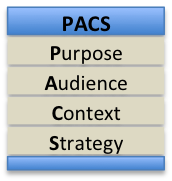|
You need to communicate with another person, but you’re a bit fuzzy about how you’re going to approach the situation and what you’re going to say. If only there were a clear pathway to help you prepare!
The following four-step PACS plan (Purpose, Audience, Context, Strategy) might be just the thing you need. Step 1. Purpose First, clearly identify your purpose. Usually, your purpose will be one or more of the following—to inform, to persuade, or to enhance a relationship. Within each of these generic purposes, state precisely what you want the outcome to be. Step 2. Audience Analysis With your purpose in mind, analyze your audience, remembering that your message might have both primary and secondary audiences. Consider the audiences’ demographic (e.g., profession, age, education, gender), psychographic (e.g., interests, beliefs, attitudes, preferences), and knowledge (e.g., general and technical) factors. Think about their wants and needs. Consider that there may be both driving and restraining forces battling for and against you in their minds. For instance, they might want to learn more about your product, but their busy schedule and their current financial constraints might be exerting a powerful negative force that is working against you. Step 3. Context Analysis In addition to analyzing the audience, analyze the context in which your communication will occur. First understand the unique attributes of the industry in which the audience works—whether banking, electronics, healthcare, or other. Learn also about major competitors in the industry. Second, consider relevant factors in the audience’s organization—its purpose, products, procedures, and problems. Finally, consider the unique situational factors—your previous interactions with the audience, the level of trust that exists between you and the audience, time pressures, technical challenges, and so forth. Step 4. Strategy Finally, based on the results of the first three PAC steps, develop a communication strategy. Creatively plan how you can navigate through the context and audience challenges to achieve your overall purpose. First, develop a channel strategy—considering the relative pros and cons of available channels, determine whether to make a phone call, write an email, send a text, or talk over lunch. Second, determine your psychological strategy—your overall approach (direct or indirect), your appeal (logical and/or emotional), and your tactic (positive and/or negative). For example, assume that your purpose is to get Sydney, a sales manager you met at a recent convention, to allow you to explain and demonstrate your sales-enhancement software—ultimately to convince her to buy your product. From your audience and context analysis, you know that her organization is lagging in the industry and needs to increase sales. However, you also realize that she doesn’t know much about your product or about you as a person. Therefore, you decide that your main strategy will be to capitalize on the pressure Sydney is feeling to increase sales. Using a relatively direct approach, you will demonstrate your product and provide client testimonials and research data that validate the effectiveness of your product. Using both positive and negative tactics, you will emphasize the benefits of adopting your product, as well as the hazards of delayed action. As needed, you will also present a side-by-side comparison of your product and that of your main competitor. But first, you’ll strengthen your relationship by making a phone call to invite Sydney to lunch where you can learn more about her needs. During lunch, you will propose the idea of an onsite product demonstration. You’re now ready to pick up your phone and make the call, knowing clearly your purpose, and understanding as much as possible your audience and the context of the interaction. PACS planning has helped you feel confident and prepared. The next time you need to communicate, I invite you to plan with PACS. Remember the old adage—if you fail to plan, you plan to fail! -Bill Baker
2 Comments
6/9/2018 06:31:21 am
The significance of communication can never be overstated. It is mode through which a sender transmits his message. If the transmission remains effective, then only the receiver can receive the desired message, else not. Effective communication is always considered as the marketing strategy. I don't mean to say that communication is a strategy, but it is required for the execution of each game. Hence, this must be strategic and effectual. Thanks to Bill and Matt, for explaining a communication model. I think everybody needs to follow this for making the communication transparent and effective.
Reply
William H Baker
6/9/2018 10:15:21 am
Thanks, Alexander. Well stated. If all communication were to suddenly cease in an organization, that organization would also suddenly cease.
Reply
Your comment will be posted after it is approved.
Leave a Reply. |
AuthorsWe're Bill, Matt, and Vince, and we hope these posts will help you more effectively teach business and professional communication. If you like what you read, please consider teaching from our business and professional communication textbook. Archives
January 2022
Categories
All
|

 RSS Feed
RSS Feed